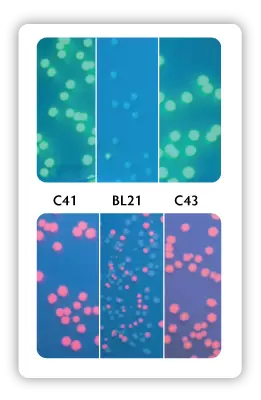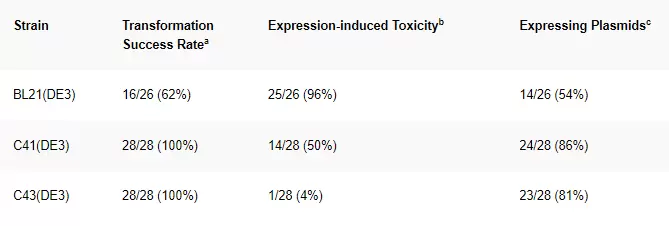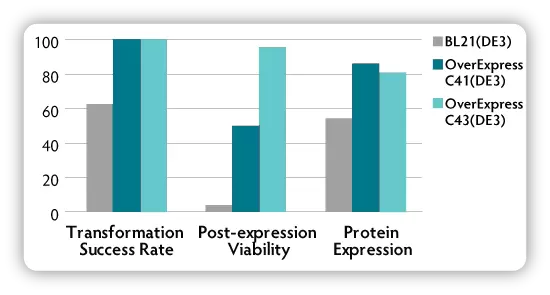OverExpress ChemComboPack (3 rxns each, 4 strains: C41(DE3) C41(DE3) pLysS C43(DE3) C43(DE3) pLysS) SOLOS > 1 x 10e6 cfu/ug
| Specifications | |
|---|---|
| Competence: | Chemically Competent |
| Application: | Difficult or Toxic Protein Expression |
| Organism: | E. coli |
Product Description
OverExpress Competent Cells - Express a wide variety of toxic proteins
- Selected for conferring tolerance to toxic proteins
- All 4 strains also available separately: C41(DE3), C41(DE3)pLysS, C43(DE3), & C43(DE3)pLysS
OverExpress Chemically Competent Cells are E. coli strains that are effective in expressing toxic proteins from all classes of organisms, including eubacteria, yeasts, plants, viruses, and mammals. The effectiveness of these strains in expressing toxic proteins has been validated in more than 350 publications.
As in standard BL21(DE 3) strains, OverExpress C41(DE3), C41(DE3)pLysS, C43(DE3), and C43(DE3)pLysS are lysogens of λDE3. These strains carry a chromosomal copy of the T7 RNA polymerase gene under the control of the lacUV5 promoter. These strains are suitable for production of protein from target genes cloned into T7-driven expression vectors. OverExpress C41(DE3), C41(DE3) pLysS, C43(DE3), and C43(DE3)pLysS are also deficient in the lon and ompT proteases.
OverExpress C41(DE3)pLysS and C43(DE3)pLysS carry a chloramphenicol resistant plasmid that expresses a small amount of T7 lysozyme, which is a natural inhibitor of T7 RNA polymerase. These strains are used to suppress basal expression of T7 RNA polymerase prior to induction, thus stabilizing recombinants encoding particularly toxic proteins. Chloramphenicol (34 µg/mL) should be added to the media to maintain the pLysS plasmid.
Which OverExpress cell strain should I use?
It is difficult to predict which of the four OverExpress strains – C41(DE3), C43(DE3), C41(DE3)pLysS, or C43(DE3)pLysS – will work best in expressing a given protein. We recommend initially using the OverExpress ComboPack™, which contains 3 reactions each of the four OverExpress competent cell strains, to determine which one is best for your application.
Transformation Efficiencies:
OverExpress C41(DE3) and C43(DE3):
≥ 1 x 109 cfu/µg pUC19
OverExpress C41(DE3) and C43(DE3):
≥ 1 x 106 cfu/µg pUC19
Genotypes
OverExpress C41(DE3) and C43(DE3):
F- ompT hsd SB (r- mB-) gal dcm (DE3)
OverExpress C41(DE3)pLysS and C43(DE3)pLysS:
F- ompT hsd SB (r- mB-) gal dcm (DE3) pLysS (CmR)
Supporting Data
The OverExpress strains contain genetic mutations phenotypically selected for conferring tolerance to toxic proteins. The strain C41(DE3) was derived from BL21(DE3). This strain has at least one uncharacterized mutation, which prevents cell death associated with expression of many recombinant toxic proteins. The strain C43(DE3) was derived from C41(DE3) by selecting for resistance to a different toxic protein and can express a different set of toxic proteins to C41(DE3). Figure 1 graphically illustrates the advantages of the OverExpress Competent Cells, compared to standard BL21(DE3) cells, in expressing toxic proteins.

Figure 1. Green Fluorescent Protein (top) or Red Fluorescent Protein (bottom) expressed from a T7 promoter construct that was transformed into C41, BL21, or C43 competent cells spread on IPTG plates to induce protein expression.
Table. 1 and Figure. 2 summarise transformation effectiveness, tolerance of expression-induced toxicity, and protein expression for T7 expression plasmids coding for a variety of recombinant proteins. These results demonstrate that the OverExpress C41(DE3) and C43(DE3) strains are clearly superior to the parental BL21(DE3) in transformation and expression of toxic proteins.

Table 1. Comparison of OverExpress C41(DE3) and C43(DE3) cells with the parental strain BL21(DE3) in transformation and expression of heterologous proteins.**

Figure 2. Comparison of OverExpress C41(DE3) and C43(DE3) cells with the parental strain BL21(DE3) in transformation and expression of heterologous proteins.**
a Transformation success corresponds to the presence of colonies on LB+ampicillin agar following transformation with a plasmid.
b Expression toxicity corresponds to the absence of colonies on LB+ampicillin+IPTG agar following transformation with a plasmid.
c Expressing plasmids corresponds to observation of a heterologous protein in the total cell pellet on Coomassie-stained SDS-PAGE following growth of a colony in LB+ampicillin medium and induction with IPTG.
**L. Dumon-Seignovert, G. Cariot, and L. Vuillard (2004). Protein Expression and Purification 37, 203-206. Data used with permission.
Which OverExpress cell strain should I use?
It is difficult to predict which of the four OverExpress strains – C41(DE3), C43(DE3), C41(DE3)pLysS, or C43(DE3)pLysS – will work best in expressing a given protein. We recommend initially using the OverExpress ComboPack™, which contains 3 reactions each of the four OverExpress competent cell strains, to determine which one is best for your application.
Custom Configurations
Please contact us for more information related to custom competent cell services or to receive a bulk quotation.
- Catalog Number
60452-1-LU - Supplier
Lucigen - Size
- Shipping
Dry Ice

